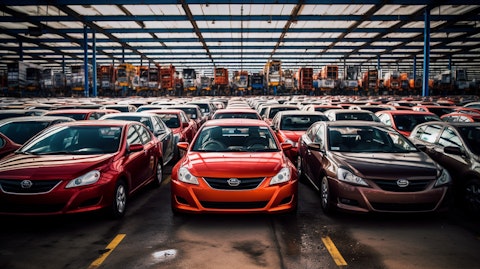Uxin Limited (NASDAQ:UXIN) Q4 2024 Earnings Call Transcript July 31, 2024
Operator: Ladies and gentlemen, thank you for standing by and welcome to the Uxin Limited Fourth Quarter and Fiscal Year 2024 Earnings Conference Call. [Operator Instructions] Today’s conference call is being recorded. If you have any objections, you may disconnect at this time. I would now like to introduce your host for today’s call, Mr. Jack Wang. Please go ahead, Jack.
Jack Wang: All right. Thank you, Operator. Hello, everyone. Welcome to Uxin’s Earnings Conference Call for the Fourth Quarter and Full Fiscal Year ended March 31st, 2024. On the call with me today, we have D.K., our Founder and CEO; as well as John Lin, our CFO. D.K. will review business operations and company highlights, followed by John, who will discuss financials and guidance. They will both be available to answer questions during the Q&A session that follows. Before we proceed, I would like to remind you that this call may contain forward-looking statements which are inherently subject to risks and uncertainties that may cause actual results to differ from our current expectations. For detailed discussions of the risks and uncertainties, please refer to our filings with the SEC. And now with that, I will turn the call over to our CEO, D.K. Please go ahead, sir.
Kun Dai: [Foreign language] Hello, everyone. Thank you for your continued interest and support. It’s a pleasure to welcome you to our earnings call today. And to better communicate with our domestic and international investors, I will be discussing our performance over the last fiscal year as well as providing insights into our prospects in both Chinese and English. The current economic landscape in China is entering a new phase of development, bringing numerous challenges to various industries, including the used car sector. Notably, the competitive pricing strategies initiated by car manufacturers early last year have severely disrupted the price structure of the used car market, leading to a substantial decline in profitability across the industry.
However, we are pleased to see opportunities amidst these challenges. Over the past year, China’s used car market has continued its rapid growth trajectory, with national used car transactions surpassing 18 million units in 2023, reflecting a near 15% year-over-year increase. The government’s series of favorable policies to encourage the development of the used car industry, coupled with substantial incentives for trading in old cars for new ones, have spurred consumption growth in the sector. In an increasingly complex and dynamic operating environment, resources are beginning to concentrate towards leading used car dealers, providing long-term sustainable growth and profitability opportunities for companies that excel in scale, branding, and efficiency.
Uxin’s unique business model characterized by our flagship used car superstores has demonstrated strong competitive advantages across various dimensions, becoming increasingly prominent in the cities where our superstores are located. In the four quarters of fiscal year 2024, our retail sales continued to grow with a total of 10,179 units sold throughout the year. From January to March, 2024, even during the traditional slow season of the spring festival, we achieved retail sales of 3,124 units, a 38% increase compared to the same period last year. Our superstores have become the leading brand in their respective regions with a net promoter score or NPS consistently around 60 points for 10 consecutive quarters; the highest level in the industry and a regional market share of 10% and growing.
Our overall vehicle inventory turnover days are around 30 days and our standardized, streamlined and digitized operating system has matured over the past year, significantly surpassing the industry average in operational capacity and efficiency. Reflecting on the past year, we have made substantial progress in numerous areas of our business, positioning us well for scalable profitability, and I will highlight 3 key achievements. First, our branding and sales capabilities have generated a positive flywheel effect, further enhancing sales efficiency. By connecting with customers through superior products and services, we have built a stronger network effect in regional markets as customers’ trust and reputation has grown, further boosting sales conversion rates.
As a result, our in-store customer conversion rate has reached approximately 40%. Despite intense industry competition, our retail vehicle inventory turnover rate has improved by over 60% compared to the previous fiscal year, allowing us to achieve higher retail sales with the same inventory size. Uxin’s decade-long industry experience has greatly empowered our sales capabilities through digitization. Our AI pricing model dynamically monitors 600,000s of used car data points across the Internet, creating competitive models based on factors such as the car’s model, age, condition, and mileage. This system, combined with customers’ viewing records and offline test drives, can generate purchase and sale prices and adjust them promptly to ensure Uxin’s vehicles remain highly competitive in the market.
During the new car price cuts, our pricing system responded quickly to adjust the acquisition and selling prices of similar models to accelerate the sales of impacted inventory. By adjusting our prices faster, we can accelerate vehicle sales, mitigate the effects of new car price reductions, and transition into the next regular sales cycle sooner. Second, while increasing the sales volume, we have also boosted our gross profit per vehicle. Our gross profit margin has risen from 1.2% in fiscal year 2023 to 5.9% in fiscal year 2024. In the used car industry, prices typically decrease as inventory ages. Therefore, by accelerating our sales turnover, we have naturally enhanced our gross profit per vehicle. Meanwhile, leveraging our one-stop shopping experience at offline superstores and reconditioning factories, we have continuously expanded our high-margin value-added services.
These include financing services, insurance, extended warranties, premium accessories, and maintenance. Over the past year, the penetration rate of these value-added services has rapidly increased, boosting our gross profit margin. Additionally, our per-vehicle reconditioning costs have significantly decreased. Uxin’s transparent factory is now fully operational, with vehicles taking an average of only 3 days to move from warehousing to sales, allowing for faster sales entry. Through bulk procurement of parts, SMART repairs, and the application of 3D printing technology, our reconditioning cost per vehicle in fiscal year 2024 has decreased by 50% compared to the previous fiscal year. Third, we have continued to reduce costs, improve efficiency, and optimize our operating expenses.
Adjusted EBITDA for the fiscal year of 2024 was a loss of RMB 176 million, representing a nearly 40% reduction in losses compared to the fiscal year of 2023. And this year, we implemented a series of cost-reduction and efficiency-enhancement measures. Looking forward, we expect fixed costs and expenses in the fiscal year of 2025 to be reduced by over RMB 100 million compared to the fiscal year of 2024, driving faster overall adjusted EBITDA profitability at the company level. Take marketing as an example. We have developed a highly cost-effective customer acquisition strategy, reducing advertising and promotion expenses by more than 50% compared to last year. Leveraging our large venues, we actively explored community-integrated marketing strategies by organizing events such as sports meetings, anime conventions, job fairs, and vehicle test drives, et cetera.

These activities increased our regional market exposure, generating substantial organic traffic and significantly lowering customer acquisition costs. In the past year, our offline superstore model has proven successful, placing Uxin on a rapid growth trajectory. Looking ahead to the new fiscal year, we have set 3 primary business objectives, aligning with our current development plan. First, we aim to significantly increase sales volume, projecting a year-over-year retail sales growth of 150% for fiscal year 2025. We are confident in maintaining our current sales efficiency and will gradually ramp up inventory, expecting inventory levels to increase 2 to 3x compared to the beginning of the fiscal year. This will drive continuous retail sales growth in the coming quarters, ensuring the achievement of our sales targets for the new fiscal year.
Second, we plan to achieve company-wide profitability at scale. Our goal is to achieve positive adjusted EBITDA for the entire company in the quarter between October and December, 2024. With new car prices now stabilizing, the profitability of used cars is beginning to recover, and our inventory scales and sales continue to climb. We are confident in meeting this profitability target. And third, we will finalize the location selection and operation preparations for 2 to 3 new superstores, enhancing our integrated online and offline superstore network. Recently, we announced a strategic partnership with the Zhengzhou Airport District government, with a joint investment of RMB 170 million to establish a new Uxin used car superstore in Zhengzhou city.
As a transportation hub in Central China and one of the most active cities for used car transactions, Zhengzhou boasts a population of over 13 million and a car ownership of 5 million, making it an ideal location for operating a super large-scale used car superstore. And besides Zhengzhou, we are also advancing implementation plans in several other cities, which will drive Uxin’s national expansion and business growth in the coming years. Everything is in place for us to achieve our goals. We have confidence in the competitive advantage of Uxin’s superstore model and the momentum driving our business growth. We remain dedicated to leading the transformation and upgrading of China’s used car industry with a steadfast commitment to customer-centric value creation.
Once again, we sincerely thank you for your continued trust and support. We look forward to achieving new breakthroughs together in the coming fiscal year. And with that, I’d like to turn the call over to our CFO to walk you through the financial results. John, please?
John Lin: Thank you D.K. and hello, everyone. I will provide a closer look at our financial results from the fourth quarter and fiscal year 2024. To facilitate communication with both domestic and international investors on the call, I will make my remarks in both Chinese and English. As we review our performance in the fourth quarter of fiscal year 2024, which ended March 31, 2024, we faced the traditional off-season for used car sales due to the Chinese New Year. Nevertheless, the enhancement of our brand strength, as well as product and service quality, enabled us to deliver remarkable sales results with a total retail transaction volume of 3,124 units, a 38% increase compared to the same period last year. The total retail revenue for the fourth quarter was RMB 269 million, representing a 2% year-over-year increase.
Despite certain challenges in the current domestic economic landscape and the ongoing intense price competition among domestic carmakers, we proactively adjusted our inventory structure to adapt to market changes. The average selling price, or ASPs, of our retail vehicles decreased from RMB 117,000 in the same period last year to RMB 86,000 this quarter. However, the significant change in sales volume offset the impact of the price reduction. Our wholesale transaction volume in the fourth quarter decreased by 31% year-over-year to 934 units, leading to a total wholesale revenue of RMB 39.7 million. With our offline superstore model not fully operational, we are focusing more on the retail vehicle business and the proportion of wholesale business will naturally decrease over time.
As such, our total revenues in the fourth quarter were RMB 319 million and importantly, our turnover efficiency has reached a new height amidst increasing market fluctuations, with the overall inventory turnover decreasing from 45 days at the beginning of the fiscal year to approximately 30 days currently. Faster vehicle turnover has allowed us to achieve higher net vehicle income. Additionally, the penetration rate of value-added services has been steadily increasing, driving the gross profit margin for the quarter up to 6.6%, compared to 4.8% in the previous quarter and 2.3% in the same period last year, and we anticipate further growth in our gross profit margin. We also further enhanced our operational efficiency and maintained strict cost control measures.
As part of this ongoing effort, we have completed organizational adjustments and structural optimizations in March. In the first quarter, our adjusted EBITDA loss was RMB 39.7 million, a reduction of RMB 4.1 million compared to the previous quarter. Regarding the full fiscal year 2024 performance, our total retail transaction volume totaled 10,179 units and despite the impact of the new car price wars, we maintained continuous sales growth across all four quarters, achieving a retail revenue of RMB 1.02 billion and total revenues of RMB 1.38 billion. Our offline superstore business model is now fully operational, enabling us to narrow our adjusted EBITDA loss by RMB 104 million, nearly 40% from the previous fiscal year to RMB 176 million. Detailed information on our financial results from the fiscal year can be found in our recently released earnings report and annual report, so I won’t repeat them here.
In January 2024, we achieved adjusted EBITDA profitability at a superstore level for the first time. With new car prices stabilizing, we have already begun gradually increasing inventory levels. Meanwhile, maintaining our current vehicle turnover efficiency will drive sustained sales growth. Additionally, we expect fixed costs and expenses for the fiscal year of 2025 to be reduced by over RMB 100 million compared to the fiscal year of 2024, accelerating the achievement of company-wide adjusted EBITDA profitability. Moving on to the outlook for the first quarter of fiscal year 2025, which ended June 30, 2024, we expect our retail transaction volume to reach 4,000 units, representing a sequential increase of over 25%. Wholesale transaction volume is expected to be 1,500 units.
Total revenues are projected to be between RMB 390 million and RMB 410 million. We also anticipate that our gross profit will remain stable compared to the fourth quarter of fiscal year 2024. As for the full fiscal year of 2025, we project a retail transaction volume of around 25,000 units, representing a year-over-year increase of 150%. Our goal is to achieve company-wide adjusted EBITDA profitability starting from the third quarter of the fiscal year, which is from October to December in 2024. And that concludes our prepared remarks for today. Operator, we are now ready to take questions.
Q&A Session
Follow Uxin Ltd (NASDAQ:UXIN)
Follow Uxin Ltd (NASDAQ:UXIN)
Receive real-time insider trading and news alerts
Operator: [Operator Instructions] And your first question will come from Fei Dai with TF Securities.
Fei Dai : We noticed that the company recently entered a strategic cooperation with Zhengzhou worth RMB 170 million. Can you elaborate on this cooperation and how long it will take for the new superstore to achieve profitability? Additionally, what is the company’s strategy for selecting new cities for expansion? And are there any other cities currently in progress?
Kun Dai: This is D.K. I will address that question. You’re correct. We have recently signed a contract with the Zhengzhou city government, and the local government plans to provide substantial support for our used car business in the area. And in addition to the joint investment of RMB 170 million for our Zhengzhou superstore operation, the government also plans to invest an additional RMB 500 million in constructing the superstore site. The government will also offer industry subsidies, facilities and other — various other support to ensure that our project in Zhengzhou can commence as soon as possible. The construction of the store will take some time and is expected to be completed next year. Our offline superstore models in Xi’an and Hefei are running smoothly, and we anticipate that the new superstore will take approximately 12 months or less from commencement to achieving EBITDA profitability.
So when choosing new areas for expansion, we prioritize cities with large vehicle ownership, high activities in used car transactions, and superior traffic conditions. For example, Zhengzhou is a transportation hub in Central China and one of the most active cities for used car transactions, with over 13 million residents and a vehicle ownership of 5 million, making it an ideal location for a new superstore. We also consider specific city conditions such as available land plots, and whether government support aligns with our needs for expanding new superstores. Given the backdrop of policies encouraging the development of the auto after-market, local governments are very supportive of our offline superstore model. We are currently in negotiations with multiple cities and expect to finalize cooperation with 1 to 2 cities within this year, so please do stay tuned for our further announcement on this front.
And that’s our answer to the first question.
Jack Wang: And we actually do have another question from Water Tower Research, who couldn’t be here in person. So I would just ask that question on behalf of them. The question is, how is our used car — used new energy vehicle business developing and what percentage of Uxin’s inventory do they make up? Compared to fuel-powered used cars, are there major differences in profitability and cost when selling used new energy vehicles?
Kun Dai: The growth rate of NEV sales in China this year has indeed been very impressive with their market share in new car sales now approaching 50%. We’re keeping a close eye on this trend, and since the NEV boom only started in the last 2 to 3 years, their total ownership is only about 25 million, which is less than 10% of the national vehicle ownership of 340 million. Most NEVs haven’t yet entered the used car sales space yet, so currently the proportion of our NEV sales is between 10% to 15%, which is still above market level. From our experience, the profitability of used NEVs is slightly higher than that of fuel-powered used cars. Firstly, used NEVs offer excellent value for money and due to their shorter update cycle and some characteristics similar to electronic consumer goods, their sales turnover rate is higher than that of fueled cars, leading to higher price markups.
Additionally, since NEVs generally have a shorter average age, their condition and battery status are relatively better and they do not involve issues with engines and transmissions, resulting in lower average reconditioning costs compared to fuel-powered cars. From our perspective as a professional used car retailer, there is no significant difference in the fundamental operations between used NEVs and fuel-powered cars. Our operational system fully supports the acquisition, reconditioning, sales and after-sales services for used NEVs. We’ve built a database of NEVs as well, including brands like Tesla, BYD, NIO, XPEV and Li Auto, et cetera, and have invested in price monitoring, value retention systems and battery assessment equipment. We’re also working with the National Big Data Alliance for New-Energy Vehicles, core suppliers in the supply chain, and vehicle manufacturers to promote a series of technical and informational collaborations to prepare for the used NEV business.
We believe that with the rapid development of NEVs in China, the proportion of NEVs in our retail business will continue to increase, and we’re fully prepared to capture that opportunity. And that’s our answer to the second question.
Jack Wang: Operator, let’s see if we have any other questions.
Operator: [Operator Instructions] And this concludes our question and answer session for today. I would now like to hand the call over back to management for any closing remarks. Please go ahead.
Jack Wang: All right. Thank you again for joining today’s call and for your continued support in Uxin. We look forward to speaking with you again in the future. Thank you.
Operator: The conference is now concluded. Thank you for attending today’s presentation. You may now disconnect.
Follow Uxin Ltd (NASDAQ:UXIN)
Follow Uxin Ltd (NASDAQ:UXIN)
Receive real-time insider trading and news alerts





